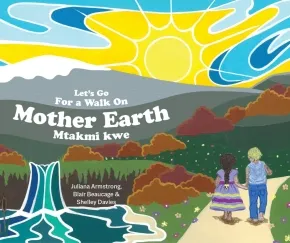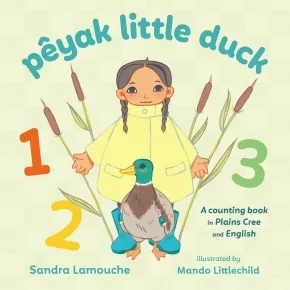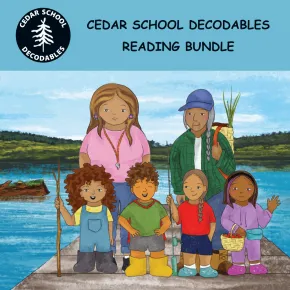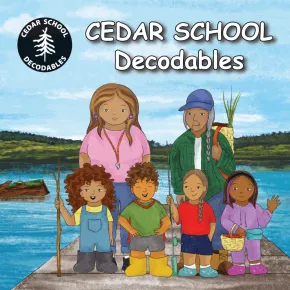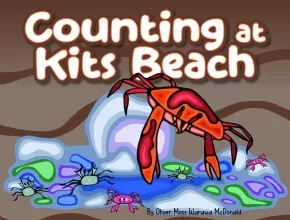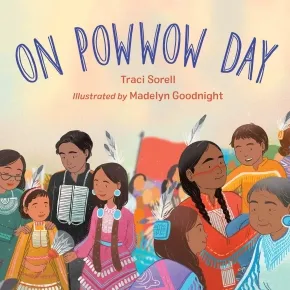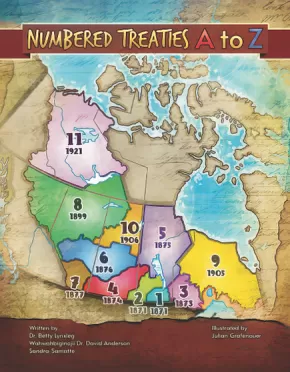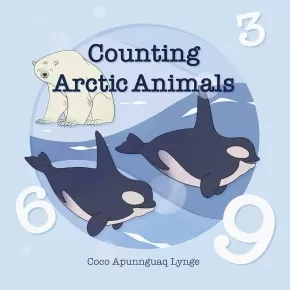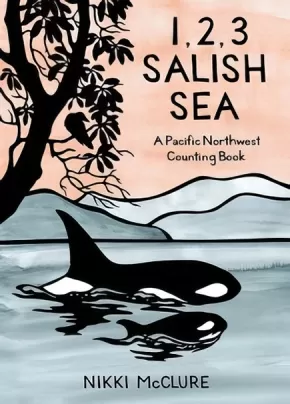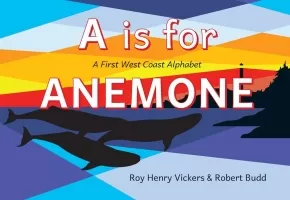
ABCs and 123s
1
-
15
of
51 Results;
Sort By
Go To
of 4
Let's Go For a Walk on Mother Earth
$22.99
Artists:
Format:
Hardcover
Text Content Territories:
Indigenous Canadian; First Nations; Anishinaabeg;
ISBN / Barcode: 9781778540653
Synopsis:
Synopsis:
Today is a good day to go for a walk on Mother Earth.
Come on a journey with young Sachiiwin and Waawaasbiikse as they count all the wonderful animals they can see. With each new animal friend, learn their Anishinaabemowin name, and discover what makes them special.
This delightful resource for little ones from Ojibway author, Juliana Armstrong, combines concepts of counting, Anishinaabemowin language learning, and traditional teachings. Accessible, repetitive and gentle, this book offers readers a space to celebrate the beauty of language, and reflect on what guides us in our own walk on Mother Earth.
Educator Information
Recommended for ages 4 to 11.
This is not a fully dual-language book, but it includes the Anishinaabemowin name for each animal in the story.
Additional Information
32 pages | 11.00" x 8.50" | Hardcover
Owls See Clearly at Night/Lii Yiiboo Nayaapiwak lii Swer: A Michif Alphabet/L'Alfabet Di Michif
$25.85
Artists:
Format:
Hardcover
Text Content Territories:
Indigenous Canadian; Métis;
ISBN / Barcode: 9781772290592
Synopsis:
Synopsis:
This picture book is a small glimpse, from A to Z, of some of the sights and sounds of the Michif language and its speakers.
The language of the Metis, Michif is a combination of French and Cree with a trace of other regional languages. Once spoken by thousands of people across the prairies of Canada and the northern United States, Michif is now so little spoken that it might disappear within a generation.
This alphabet book is part of a resurgence to celebrate and preserve the traditions of the Metis people. Here Michif and English words combine with images from Metis culture to introduce all generations to the unique Michif language. The book even includes a brief introduction to the language's history, a pronunciation guide, and a list of references for those interested in learning more about Michif.
Educator Information
Recommended for ages 5 to 8.
Dual-language: English and Michif.
Additional Information
56 pages | 8.25" x 9.00" | Hardcover
pêyak little duck
$21.95
Artists:
Format:
Hardcover
Text Content Territories:
Indigenous Canadian; First Nations; Cree (Nehiyawak); Plains Cree;
Grade Levels: Preschool; Kindergarten;
ISBN / Barcode: 9781459837171
Synopsis:
Synopsis:
Let's go on a walk and practice our language!
What birds will we see? I see one sîsîp / pêyak little duck!
In a celebration of the connection between language learning and the land, a young child enjoys a walk in nature and spots different birds while practicing counting from one to ten in Plains Cree. With bright illustrations, rhyming clues in English and pronunciation guides on every page, pêyak little duck is a friendly introduction to Plains Cree and a celebration of the beauty of springtime in the Prairies and the Plains.
Educator Information
Recommended for ages 3 to 5.
Learn to count from one to ten in Plains Cree.
Simple rhyming English text complements Plains Cree vocabulary to help readers learn and practice the numbers one through ten. Illustration labels for birds and other natural objects are an opportunity for additional language learning.
Pronunciations are given beside each Cree number to support readers in their learning. The rhyme and rhythm of the English text also provides clues about how the Cree is pronounced. Additional pronunciations and information about language learning are provided in the back matter.
Additional Information
32 pages | 9.00" x 9.00" | Hardcover
Cedar School Decodables - Reading Bundle
 $958.80
$958.80

Grade Levels: Kindergarten; 1;
ISBN / Barcode: 978-1-77174-657-1
Synopsis:
Synopsis:
Welcome to Cedar School! Join Liv, Tom, Gus, and Bell as they learn on the land and explore Mi’gmaw teachings with their teacher, Miss Sam, and the school’s Mi’gmaw Elder, Jen. With charming illustrations and simple storylines, this decodable series engages students as they practise their reading skills. Each book includes a pre-reading review of non-decodable words, and many of the books introduce special words related to Indigenous teachings. Talking Together prompts facilitate discussions led by the reading teacher.
Developed in partnership with Dyslexia Canada, Cedar School Decodables is a series of 20 decodable books for young readers. Designed for students who have previously learned short vowel and consonant sounds, additional phonic skills are developed progressively throughout the series. Cedar School Decodables is divided into six sets, which increase in word count and complexity of sentence structure:
Set 1 – Short Vowels (40-60 words)
Set 2 – Digraphs (60-80 words)
Set 3 – VCe (80-90 words)
Set 4 – Longer Words (90-100 words)
Set 5 – Ending Spelling Patterns (100-110 words)
Set 6 – R-Controlled Vowels (110-125 words)
Educator Information
This bundle includes 120 books: six copies each of the 20 Cedar School Decodables titles. The Cedar School Decodables Teacher’s Guide, which will be available for purchase at a later date, is not included in this bundle.
This series is recommended for ages 4 to 7 for use in kindergarten and Grade 1 classrooms.
Additional Information
Each book is 16 pages | 6.5” x 5.5” | Paperback | Reading Bundle ISBN: 9781771746571
Cedar School Decodables - Series Bundle
 $159.80
$159.80

Text Content Territories:
Indigenous Canadian; First Nations; Mi'kmaq (Mi'gmaq); Listuguj Mi'gmaq First Nation;
Grade Levels: Kindergarten; 1;
ISBN / Barcode: 978-1-77174-655-7
Synopsis:
Synopsis:
Welcome to Cedar School! Join Liv, Tom, Gus, and Bell as they learn on the land and explore Mi’gmaw teachings with their teacher, Miss Sam, and the school’s Mi’gmaw Elder, Jen. With charming illustrations and simple storylines, this decodable series engages students as they practise their reading skills. Each book includes a pre-reading review of non-decodable words, and many of the books introduce special words related to Indigenous teachings. Talking Together prompts facilitate discussions led by the reading teacher.
Developed in partnership with Dyslexia Canada, Cedar School Decodables is a series of 20 decodable books for young readers. Designed for students who have previously learned short vowel and consonant sounds, additional phonic skills are developed progressively throughout the series. Cedar School Decodables is divided into six sets, which increase in word count and complexity of sentence structure:
Set 1 – Short Vowels (40-60 words)
Set 2 – Digraphs (60-80 words)
Set 3 – VCe (80-90 words)
Set 4 – Longer Words (90-100 words)
Set 5 – Ending Spelling Patterns (100-110 words)
Set 6 – R-Controlled Vowels (110-125 words)
Educator Information
This bundle includes 20 books: one copy each of the 20 Cedar School Decodables titles. The Cedar School Decodables Teacher’s Guide, which will be available for purchase at a later date, is not included in this bundle.
This series is recommended for ages 4 to 7 for use in kindergarten and Grade 1 classrooms.
Additional Information
Each book is 16 pages | 6.5” x 5.5” | Paperback | Series ISBN: 9781771746557
Cedar School Decodables: A Forest of Numbers
 $7.99
$7.99

Artists:
Format:
Paperback
Text Content Territories:
Indigenous Canadian; First Nations; Mi'kmaq (Mi'gmaq); Listuguj Mi'gmaq First Nation;
Grade Levels: Kindergarten; 1;
ISBN / Barcode: 978-1-77174-649-6
Synopsis:
Synopsis:
In this story, the class practises their math skills in the forest by counting what they see. How many birds are in the trees?
Mi’gmaq use math when building, crafting, and making art. Math skills can be used every day!
Can you count along with Bell, Gus, Liv, and Tom?
Educator Information
Recommended for ages 4-7, for use in kindergarten and Grade 1 classrooms.
Cedar School Decodables is divided into six sets, which increase in word count and complexity of sentence structure. A Forest of Numbers is in Set 4 – Longer Words, and reviews open/closed syllable words. Books in Set 4 have 90-100 words.
Readers should be familiar with the concepts included in Set 1 to Set 4:
- consonants
- beginning and end blends
- short and long vowels
- digraphs
- a /o/
- s – /s/ and /z/
- -s, -es, -ed, and -ing suffixes
- VC-CV, V/CV, VC/V, and compound words
- possessives
Series Information
Welcome to Cedar School! Join Liv, Tom, Gus, and Bell as they learn on the land and explore Mi’gmaw teachings with their teacher, Miss Sam, and the school’s Mi’gmaw Elder, Jen. With charming illustrations and simple storylines, this decodable series engages students as they practise their reading skills. Each book includes a pre-reading review of non-decodable words, and many of the books introduce special words related to Indigenous teachings. Talking Together prompts facilitate discussions led by the reading teacher.
Developed in partnership with Dyslexia Canada, Cedar School Decodables is a series of 20 decodable books for young readers. Designed for students who have previously learned short vowel and consonant sounds, additional phonic skills are developed progressively throughout the series.
The series will be accompanied by Cedar School Decodables Teacher’s Guide and a series of four picture books, which will be available at a later date.
Additional Information
16 pages | 6.5” x 5.5” | Paperback | ISBN: 978-1-77174-649-6
Counting at Kits Beach (BB)
$15.00
Artists:
Format:
Paperback
Text Content Territories:
Indigenous Canadian; First Nations; Cree (Nehiyawak);
ISBN / Barcode: 9781928120438
Synopsis:
Synopsis:
Learning to count is easy and fun with Counting at Kits Beach. Follow Oliver McDonald’s delightful and colourful pictures, which count various beings at Kits (Kitsilano) Beach, Vancouver. The images begin at ten and count down to one, the last being the sunset. Then come back to Kits Beach and watch and count again. Children ages three to six will love Counting at Kits Beach!
Educator Information
Recommended for ages 3 to 6.
Additional Information
24 pages | 8.00" x 6.50"
It Bears Repeating
$23.99
Artists:
Format:
Hardcover
Text Content Territories:
Indigenous Canadian; Inuit;
ISBN / Barcode: 9781774880555
Synopsis:
Synopsis:
This beautifully crafted picture book celebrates one of the world's most awesome animals: the polar bear. Evocative but simple text by award-winning musician and artist Tanya Tagaq is accompanied by striking art in this classic counting book.
Beginning with 1 proud polar bear standing tall and ending with 10 bears waving goodbye, this delightful counting book shows polar bears in all their forms: slippery and fast, crafty and cool, hungry and proud. Tanya has created a story meant to be read aloud, incorporating simple Inuktitut words and using her keen ear for the musical sound of language.
This book is joyful, powerful, clever and striking — much like the bears who sniff, slide, swim, hunt, play and dance through its pages. And when you get to the last page, you won't be able to resist going back to repeat the journey!
Educator Information
Recommended for ages 3 to 7.
Concepts: Counting & Numbers; Animals - Polar Bears.
This book is meant to be read aloud and incorporates simple Inuktitut words.
Additional Information
24 pages | 10.50" x 9.00"
On Powwow Day (BB)
$10.99
Artists:
Format:
Board Book
Text Content Territories:
Indigenous American; Native American; Cherokee; Cherokee Nation (Cherokee Nation of Oklahoma);
Grade Levels: Preschool;
ISBN / Barcode: 9781623545765
Synopsis:
Synopsis:
In this board book by best-selling Native author Traci Sorell, discover colors, sounds, and counting from one to ten on powwow day!
This eye-catching, interactive board book is sure to keep toddlers engaged. Count one through ten as you make your way through the day of the powwow, looking for colors, family members, jingle dresses, musical instruments, and tribal citizens in this introduction to a traditional Native event.
An award-winning children's picture book adapted to be ready for little listeners in a warm and vibrant board book edition.
Reviews
"A colorful counting book engages children to identify the different visual elements that occur on powwow day. From the car that vrooms to the shaking shiny jingle cones, the exciting expressions catch more beyond the eye. The rainbow palette is shown off in organic and youthful design work. Every number from one to ten has a corresponding color, attached to a powwow day element. Readers can identify and count these elements, from the gray feathers on regalia to the bright moccasins. VERDICT This delightful picture book allows Indigenous children to connect with and feel pride in the abundance of powwow participation, and gives all readers a great counting book full of cultural imagery."—School Library Journal, starred review
Educator Information
Recommended for ages 3 and under.
Additional Information
20 pages | 5.88" x 5.88" | Board Book
The Cherokee Syllabary: An Illustrated Key to the Cherokee Language
$21.95
Artists:
Format:
Hardcover
Text Content Territories:
Indigenous American; Native American; Cherokee;
ISBN / Barcode: 9781570674228
Synopsis:
Synopsis:
The Cherokee Syllabary: An Illustrated Key to the Cherokee Language reintroduces adults as well as children to their language once again. The introduction and pronunciation key aid in understanding the beautifully illustrated syllabary characters. Accompanying each illustration is a Cherokee word that contains the Cherokee syllabary character, the Cherokee sounds of each syllabary character in the word, the word in English and a row of syllabary characters with sound of each below. Young children will be enchanted by the delightful illustrations. The concept for the illustrations was influenced by medieval illuminated manuscripts. The book is a valuable educational resource for schools and libraries that adds multicultural diversity to their classrooms and collections.
Educator Information
Recommended for ages 6 to 8, but anyone learning the Cherokee language could find this useful.
Includes an Understanding the Text page, nothing that the Cherokee alphabet isn't an alphabet but a syllabary (each Cherokee character represents a complete syllable) and explaining more about the information in the book.
Additional Information
40 pages | 8.50" x 8.50" | Hardcover
The Numbered Treaties A to Z
$24.95
Artists:
Format:
Paperback
Text Content Territories:
Indigenous Canadian;
ISBN / Barcode: 9781990297342
Synopsis:
Synopsis:
Let us walk together through the ABCs of the Numbered Treaties. We purposefully use the ABC, a constructed Language system from the English Language, to talk back to the Numbered Treaties, so named without reference to our Own Language system or the Land.
First Nations People entered into Treaties and Agreements prior to Confederation and negotiated the Numbered Treaties after the Confederation of Canada in 1867.
Educator Information
Recommended for grades 4 to 6.
Additional Information
Paperback
A Is for Bee: An Alphabet Book in Translation
$26.99
Artists:
Format:
Hardcover
ISBN / Barcode: 9781646141272
Synopsis:
Synopsis:
What letter does the word bee start with?
If you said "B" you're right – in English!
But in many, many languages, it actually starts with A.
Bee is Anū in Igbo,
Aamoo in Ojibwe,
Abelha in Portugese.
And Ari in Turkish.
Come and explore the gorgeous variations in the ways we talk about familiar things, unified and illuminated through Ellen Heck's eye-catching, graphic scratchboard details and hidden letterforms.
Educator Information
Recommended for ages 3 to 9.
Includes some Indigenous words.
Additional Information
40 pages | 7.75 x 10.5 | Hardcover
Counting Arctic Animals (BB)
$14.95
Artists:
Text Content Territories:
Indigenous Canadian; Inuit; Indigenous European; Greenlandic Inuit;
Grade Levels: Preschool;
ISBN / Barcode: 9781772274479
Synopsis:
Synopsis:
One bowhead whale! Two polar bears! Three orcas! Join Kuluk and Asa as they count all the animals they see! This introduction to counting and to Arctic animals helps young children develop their counting skills through short rhymes. It also introduces interesting collective nouns, like a blessing of narwhals and a bob of seals.
Reviews
"As a 1-10 counting book, Counting Arctic Animals works extremely well. While Apunnguaq Lynge’s superb illustrations are full of movement and action, she has not forgotten that each animal that is to be counted must be clearly differentiated. Highly Recommended"—CM: Canadian Review of Materials
Educator Information
Recommended for ages 2 and under.
Additional Information
24 pages | 8.00" x 8.00" | Board book
1,2,3 Salish Sea: A Pacific Northwest Counting Book (1 in stock, Out of Print)
$19.95
Artists:
Format:
Hardcover
Grade Levels: Preschool; Kindergarten;
ISBN / Barcode: 9781459827370
Synopsis:
Synopsis:
From one to ten and beyond, explore the Salish Sea in this visually striking, high-concept counting primer. Acclaimed West Coast artist Nikki McClure uses a single piece of paper and an X-ACTO knife to create her simple yet exquisite images. Whether it's one stubby squid or one million raindrops, readers young and not-so-young will delight in this distinctly Pacific picture book.
Educator Information
Recommended for ages 3 to 5.
This book is a visually striking counting primer featuring marine life from one to ten with the addition of large numbers (20, 50, 100, 500, 1000, 10,000, 100,000).
Additional Information
32 pages | 6.50" x 9.00"
A is for Anemone (BB)
$14.95
Format:
Board Book
Text Content Territories:
Indigenous Canadian;
Grade Levels: Preschool;
ISBN / Barcode: 9781550179477
Synopsis:
Synopsis:
With crisp, luminous illustrations by celebrated Indigenous artist Roy Henry Vickers, and a simple rythmic text, this sturdy board book introduces the alphabet using iconic imagery of the West Coast, creating a book that will be cherished by young readers and their families.
Starting with colourful sea anemones waving in the ocean current, and closing with a snoozing grizzly bear (Zzz), this board book supports both early literacy and children's awareness of the natural world.
Publishers Weekly described Vicker’s previous collaboration with Robert Budd as “a gorgeous glimpse of the distinctive landscapes and creatures of the Northwest, [that] will enchant residents and nonlocals alike.”
Educator & Series Information
This book is a part of the First West Coast Books series.
Recommended for ages 3 and under.
Key Topics / Concepts: ABCs, Alphabet, West Coast, Indigenous, Canadian, Earth Sciences, Water, Literacy Development, Early Learners, Indigenous Artwork.
Additional Information
28 pages | 7.25" x 5.00" | Boardbook
Sort By
Go To
of 4

